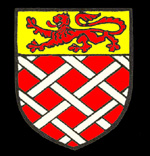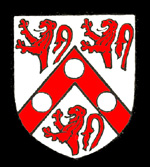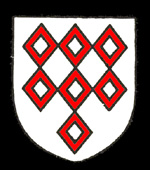Clifton Manors
The Victoria County History for Bedfordshire was published in 1910. It contains summaries of the histories of all the manors in the county, as far as then known.
Clifton Manor
This manor was three hides and half a virgates held from Remigius, Bishop of Lincoln by William de Caron at the time of the Domesday Book of 1086. The overlordship of the manor continued to be held by the Bishops of Lincoln, certainly until the end of the Middle Ages. The tenants remained the Caron family until the death of Hugh de Caron at some time before 1231, the manor then being divided between his three daughters. Margery de Caron and her husband Robert de la More conveyed their third portion to her sister Elizabeth and her husband William de Crespinges in exchange for land in Tempsford.

Spigurnel family coat of arms
It is not recorded what happened to the third share of the other daughter, Lucy but it is likely she also conveyed it to Elizabeth as she is recorded as later holding the whole manor, conveying it to Henry Spigurnel, who held it in 1316. Spigurnel died in 1328, the manor passing to his son Thomas, who was later knighted. Sir Thomas conveyed the manor to Sir Gerard Braybroke and Isabella, his wife, in 1340

Fisher family coat of arms
On Sir Gerard Braybroke's death the manor passed to his son, Gerard and so on down the Braybroke family until 1427, when it passed to Sir William Babyngton on the death of another Gerard Braybroke. Babyngton died in 1454 and it is suggested in the Victoria County History that his son conveyed the manor to Sir John Fisher, who died owning it in 1510. His son Michael succeeded him and on his death in 1549 it passed to Agnes, daughter of his son John (who had died in 1528). She married Oliver Saint John of Bletsoe and that family owned the manor until 1602 when it was conveyed to Walter Rolt the elder.
Walter Rolt the younger held Clifton Manor in 1652 but in a visitation to the county by the Bishop of Lincoln in 1667/8 it was stated: "Mr. Rolt of Clifton has sold his estate and gone out of the county". The Victoria County History states that: "the history of the manor in the eighteenth century is obscure". A deed of 1789 stating that Rolt sold the manor to a man named Trice who sold it to a man named Symcotts, who sold it to his daughter. In 1790 the manor was divided amongst the three daughters of Anne, daughter of Sir Henry Johnson of Toddington and wife of Thomas Wentworth, Lord Strafford. It is suggested that the three daughters jointly sold the manor to John Lord as his executors, in 1798, sold it to Simpson Anderson for £5,150.
In 1806 Anderson sold the estate, for £6,100 to Samuel Henley Ongley of Graffham [Huntingdonshire]. On his death in 1823 the estate was sold by auction probably to a Henry Palmer, who is recorded as holding the manor in 1832 and in 1864. It was probably sold by him to Henry Maclean Pryor from whom it passed to Ralston de Vino Pryor in the 20th century. A succession of Law of Property Acts in the 1920s abolished copyhold land tenure and all manorial fines and other ways of raising money, effectively abolishing manors in all but name.
Clifton Lacies Manor
This manor originated in two hides of land held in 1086 by William de Caron from Nigel de Albini. The overlordship later passed from the de Albinis to the Barons Saint Amand and was geld by a Peter de Saint-Croix in 1346 but is not mentioned after 1359.

Braybroke family coat of arms
As John de Lacy held the manor in 1302 it became known as Lacies Manor and in 1316 was held by Henry de Lacy. By 1346 Gerard Braybroke held this manor as well as Clifton Manor. His son Gerard alienated Lacies Manor to Edward Bromflete, who is recorded as holding it in 1428. There is no record of the manor then until 1602 when held by Walter Rolt, so Bromflete may have conveyed it to the Babyngton family so that it descended in the same way as Clifton Manor.
In 1652 Rolt mortgaged most of the land which went with the manor to Thomas Hawkes of London, but kept the manor itself, with its manor house, for himself. Eight years later, however, he sold the manor house, too, the purchaser being John Trice from Godmanchester [Huntingdonshire] though in 1666 John Dixie, Rolt's executor (he had died in 1661) was still Lord of the Manor [GA1327] but that was also acquired at some later date by the heirs of William Symcotts, who had bought the manor house from Trice in 1664 [M1/10/4].
Symcotts' estates in Clifton passed to the children of one of his three daughters, Ann, wife of John Crawley as, in his will of 1752, Thomas Crawley, their son, left the Manor of Lacies and its "capital messuage" to John Lord, Rector of Drayton Parslow [Buckinghamshire], a maternal cousin. In his will [X125/50], proved in 1778, Lord left his estates to trustees for sale and in 1798 Clifton Lacies was sold to Simpson Anderson. Who also had the Manor of Clifton, thus reuniting Rolt's estate and the two manors then descended together until the 1920s.
The Manor held by the Knights Hospitaller of Saint John of Jerusalem
This manor had its genesis in six and a half hides held by William de Caron of Eudo Dapifer in 1086. The manor's overlord was the Barony of Eaton until 1303 when it passed to the Crown.
The first record putting the Knights Hospitaller in possession is dated to 1278 and they held the manor until the Dissolution of the Monasteries and other religious houses by Henry VIII (1509-1547). The Crown granted the manor to Sir Richard Longe in 1540. His son Henry is recorded as holding the manor in 1583. It later passed to his daughter and heir Elizabeth, who married William Russell, fourth son of Francis, Earl of Bedford. Their son Francis, Lord Russell, conveyed the manor to Walter Rolt, who also held the Manor of Clifton and the Manor of Clifton Lacies, in 1617. From that date the manor followed the same descent as Clifton Manor.